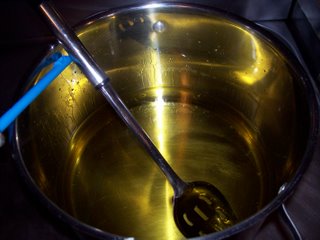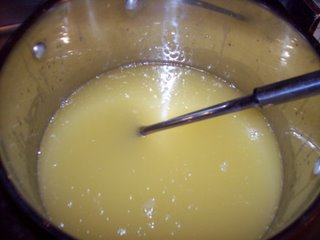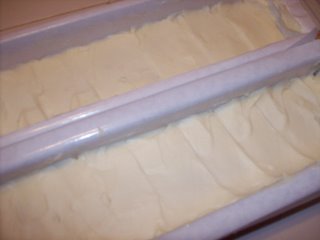The Vegetable Oils Combine
 Beautiful, aren't they? Soy, olive and coconut oils, all gently swimming around together in my soap pot on the stove until they reach 100-105 degrees F.
Beautiful, aren't they? Soy, olive and coconut oils, all gently swimming around together in my soap pot on the stove until they reach 100-105 degrees F.While these oils are melting (coconut oil is a solid at room temperature) and heating, I'm combining pure lye with water, and putting that mixture into an ice bath in order to get it DOWN to 100-105 degrees F. When you mix lye with water you get a WHOLE lotta heat, let me tell you!
And here's a little urban culture tidbit for you ... I used to be able to buy good old Red Devil Lye at the grocery store for this soap-making venture. It's the pure lye stuff that you buy to pour down your clogged-up drains to clear them out. Many other drain cleaners have flooded the market in recent years that will accomplish the same thing, drain-wise, but they have all kinds of other weird ingredients added to them, and they will NOT work in soap-making.
Welllllll....... it seems all the home-based crystal-meth manufacturers have been using Red Devil Lye to create their illicit drugs -- so most, if not all, grocery stores have pulled the stuff off their shelves. Red Devil now only sells another product that has all that other junk in it. If the junk is in it, you can't make the drugs with it. Nor can you make soap.
But thanks to all the other generous and lovely soap-making afficionados out there, I now know where to go to buy the PURE lye once again ... but I'm not advertising the fact and I'm not tellin' ya' where to get it unless you can somehow prove to me that you're making large-batch cold-process soap and your life as such will be over if you can no longer obtain pure lye ;-)



